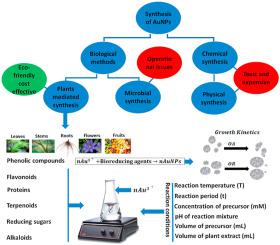Journal of Cleaner Production ( IF 9.7 ) Pub Date : 2021-05-11 , DOI: 10.1016/j.jclepro.2021.127460 Tausif Ahmad , Jibran Iqbal , Mohamad Azmi Bustam , Muhammad Irfan , Hafiz Muhammad Anwaar Asghar

|
The ecological, economical, and operational drawbacks associated with chemical, physical, and microbial modes, employed for the synthesis of gold nanoparticles (AuNPs) are the major stumbling blocks, which have confined their progressively growing industrial and medical applications. In this context, plants and their parts including leaves, flowers, steams, seeds, roots and biowastes have shown their untapped potential for the cost-effective, renewable, and eco-friendly synthesis of AuNPs. This review is majorly focused on the plant resources, explored for the phytosynthesis of AuNPs along with their as-developed surface features, detection of reactive biomolecules acting as reducing and stabilizing agents, reaction mechanism, impact of process parameters and quantitative evaluation of their growth kinetics. A critical analysis on identification of bioactive compounds in plant extracts has confirmed the key roles of phenolic compounds, flavonoids, proteins and terpenoids in the bioreduction of gold ions and biostabilization of AuNPs, explained through several reported hypothetical reaction mechanisms. The reaction period (2 min–4 days), concentration (0.2–4.055 mM) and volume of gold precursor (1.0–25 mL), reaction temperature (20–100 °C), volume of plant extract (0.2–20.0 mL) and pH of reaction mixture (2–14.0) revealed their decisive roles in forming size, morphology, and stability of as-developed AuNPs.
The predicted growth kinetics of phytosynthesized AuNPs using Ostwald ripening and Orientation attachment models were found in agreement with experimental size evolution over a period of time. This review is written with an intention to unfold the key research challenges and future directions associated with phytosynthesis of AuNPs such as identification of reactive phytochemicals, reaction conditions and mathematical estimation of growth kinetics, which may be useful for their tuneable surface features-based phytofabrication.
中文翻译:

关于金纳米颗粒植物合成的评论:问题,挑战和未来前景
与金,纳米金(AuNPs)的合成所使用的化学,物理和微生物模式相关的生态,经济和操作缺陷是主要的绊脚石,这限制了它们逐步增长的工业和医学应用。在这种情况下,包括叶,花,蒸汽,种子,根和生物废料在内的植物及其组成部分已显示出其开发具有成本效益的,可再生的和环保的AuNPs的潜力。这项审查主要侧重于植物资源,探讨了AuNPs的植物合成及其表面特征,作为还原剂和稳定剂的反应性生物分子的检测,反应机理,工艺参数的影响以及对其生长动力学的定量评估。鉴定植物提取物中生物活性化合物的关键分析已证实酚类化合物,类黄酮,蛋白质和类萜在金离子的生物还原和AuNPs的生物稳定中的关键作用,已通过几种报道的假设反应机理进行了解释。反应时间(2分钟– 4天),浓度(0.2–4.055 mM)和金前驱物的体积(1.0–25 mL),反应温度(20–100°C),植物提取物的体积(0.2–20.0 mL)反应混合物的pH和pH值(2–14.0)显示出它们对已开发的AuNPs的尺寸,形态和稳定性的决定性作用。通过几种报道的假设反应机理进行了解释。反应时间(2分钟– 4天),浓度(0.2–4.055 mM)和金前驱物的体积(1.0–25 mL),反应温度(20–100°C),植物提取物的体积(0.2–20.0 mL)反应混合物的pH和pH值(2–14.0)显示出它们对已开发的AuNPs的尺寸,形态和稳定性的决定性作用。通过几种报道的假设反应机理进行了解释。反应时间(2分钟– 4天),浓度(0.2–4.055 mM)和金前驱物的体积(1.0–25 mL),反应温度(20–100°C),植物提取物的体积(0.2–20.0 mL)反应混合物的pH和pH值(2–14.0)显示出它们对已开发的AuNPs的尺寸,形态和稳定性的决定性作用。
发现使用Ostwald熟化和定向附着模型预测的植物合成AuNP的生长动力学与一段时间内的实验尺寸演变相符。本综述旨在揭示与AuNPs的植物合成有关的关键研究挑战和未来方向,例如反应性植物化学物质的鉴定,反应条件和生长动力学的数学估计,这可能对基于可调谐表面特征的植物制造有用。











































 京公网安备 11010802027423号
京公网安备 11010802027423号